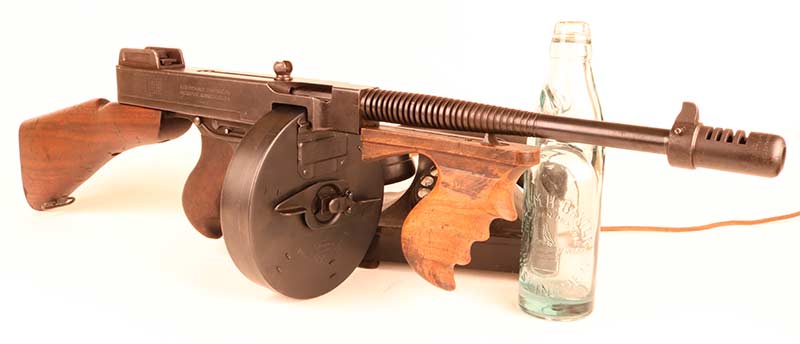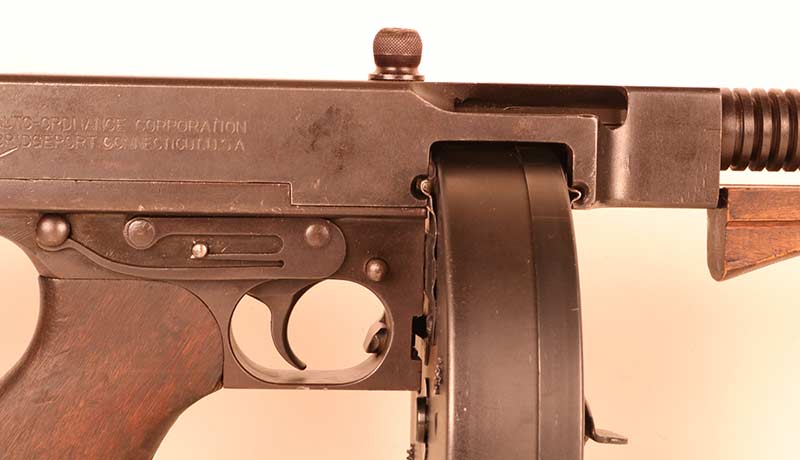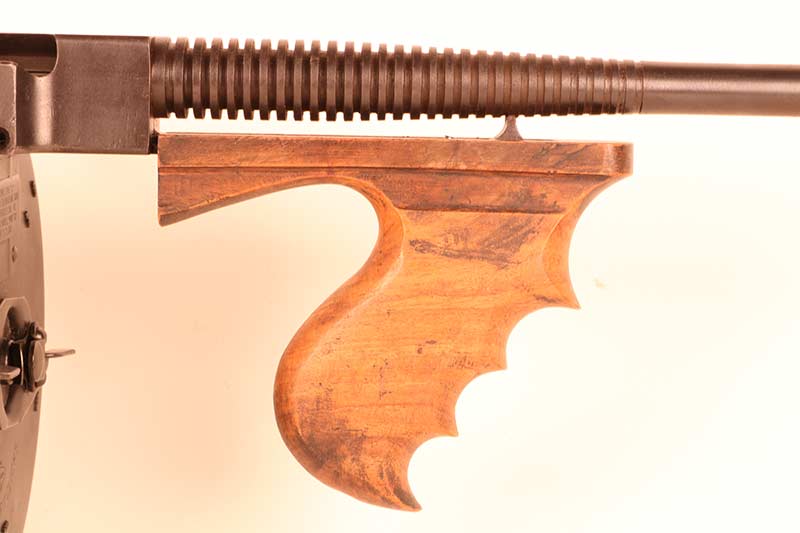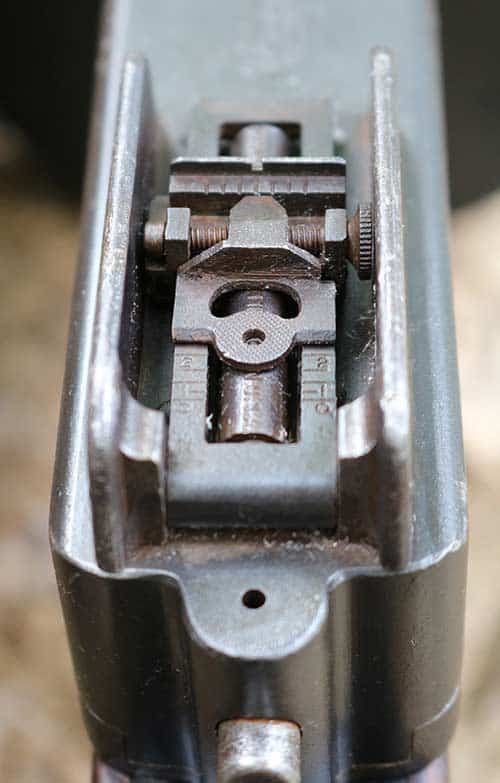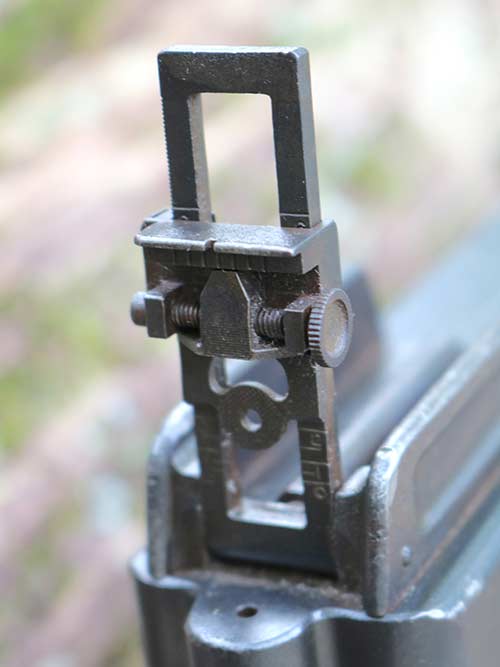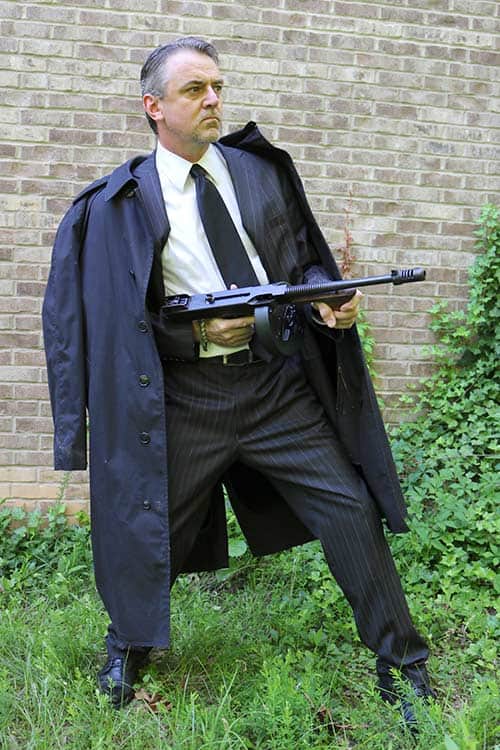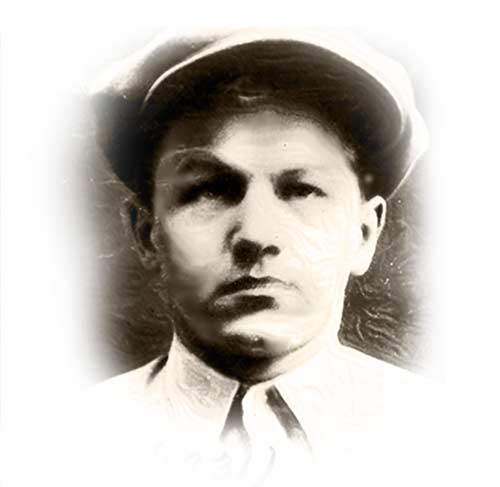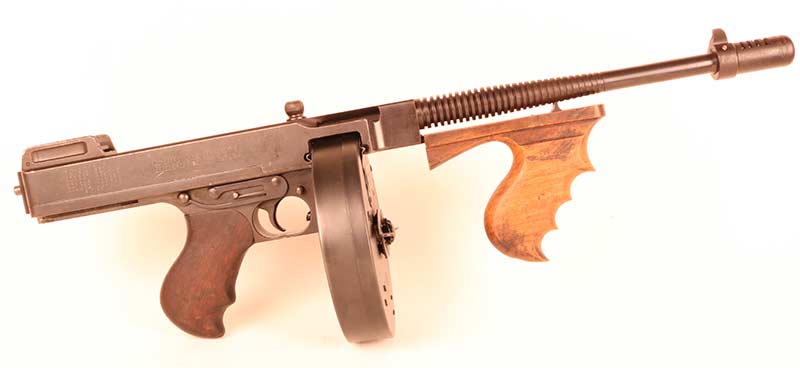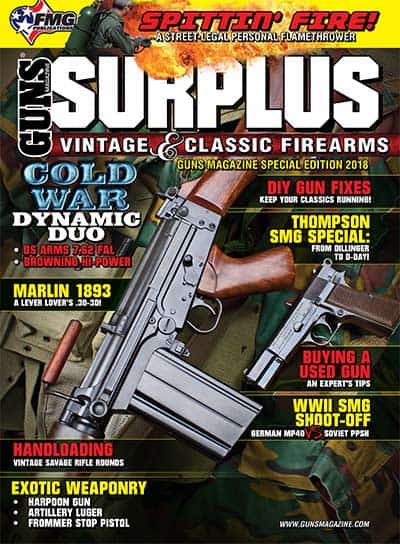Chicago Typewriter
A short history of the world’s most
storied SMG — The Tommy Gun
On June 30, 1934, at 11:30 a.m., John Dillinger calmly walked into the Merchants National Bank in South Bend, Indiana. There were 25 civilians in the bank on this clear Saturday morning, and Dillinger, along with five other bank robbers, was expecting a big score. In the next 15 minutes a policeman would be dead, six citizens would be wounded, and downtown South Bend would be transformed into a war zone.
Dillinger and his accomplices entered the bank with their weapons concealed underneath long coats despite the day’s heat. Once they had produced their guns and announced the robbery, Dillinger fired a burst from his Thompson submachine gun into the ceiling of the bank. As intended, this action thoroughly cowed everyone in the building. Most bystanders later stated they mistook the noise for fireworks.
Baby Face And Failure
Meanwhile, Lester Gillis stood guard outside the bank, fidgeting badly as the robbery unfolded while wielding a Thompson of his own. Gillis’s wife called him Les. The rest of the country knew him as Baby Face Nelson.
Homer van Meter, another lookout and longtime Dillinger associate, shot and killed 29-year-old patrolman Howard Wagner with a Winchester M1907 .351 rifle as he approached the bank to investigate the noise. A local jewelry store owner then shot Nelson in the back with a handgun. Nelson’s bulletproof vest stopped the round, but he subsequently sprayed the street indiscriminately with automatic fire. In an incredible act of bravery, a local high school sophomore named Joseph Pawlowski ran towards the gunfire and jumped onto Nelson’s back as he was firing his Thompson. They struggled for a time until Pawlowski was thrown clear and subsequently shot through the hand. Nelson apparently thought the lad dead and left him alone.
Though the six motorized bandits ultimately escaped alive, the take was markedly more meager than they had hoped. Dillinger and van Meter had planned to score enough to retire. In the next five months one of the robbers would end up in jail. The other five would be dead. As for Dillinger, he had less than a month to live.

The 50-round drum magazine was as much a part of the Thompson
legend as the gun itself. Cumbersome in action and slow to load, the
drum slides into place from the side once the bolt is retracted. The safety
and fire selector were different switches located on the left side of the
trigger housing. Only the longest of monkey fingers could reach them
both comfortably.
Iconic Firepower
John Taliaferro (pronounced “Toliver”) Thompson originally developed his eponymous gun as an implement for trench warfare in World War I. Thompson saw it as the instrument American doughboys might use to finally break out of the trench deadlock and take the fight to the Huns. Alas, the gun was not ready for shipment until after the Armistice and the war ended without Thompson’s gun having contributed.
In subsequent years Thompson marketed his weapon to government agencies, private institutions and security-minded individuals across the country. The US Postal Service was actually an early customer, having purchased 200 copies. As the gun’s $200 price tag equates to about $3,400 in today’s dollars, business was slow. By 1929 Thompson’s company had sold 10,300 guns and was in danger of bankruptcy.
The 1921 and 1928 Thompsons were essentially identical, save for the heavier actuator in the latter model that gave it a slightly slower rate of fire. These guns were heavy, cumbersome and expensive to produce. The mechanism was relatively delicate, however, and managing things like drum magazines in combat was a challenge. While the Thompson was a sub-optimal infantry tool, the argument could be made it was the finest criminal implement ever devised. Even today, little can compare with it in terms of concealable .45 ACP firepower.
Practical Tactical
Those early commercial Thompsons all sported vertical foregrips wonderfully shaped to accommodate the human hand. The Cutts compensator on the muzzle was a $20 upgrade. The actuator was situated atop the gun for easy access with either hand and the 600-yard Lyman rear sight was both absurdly complicated and thoroughly useless. The fire controls were situated on the left aspect of the gun. While 15 percent of today’s population is left-handed, apparently there were no southpaws in the Roaring Twenties.
Those early Thompsons fed from either a 20-round stick magazine or 50- or 100-round drums. The 100-round drums were ridiculously huge. The 50-rounders were slow to load and difficult to manage yet permitted a great deal of firepower. They were, however, still compact enough to hide underneath a trenchcoat.
Magazine changes could be a challenge, particularly with drums. To load a drum you retracted the bolt and slid the drum in from the side. If you weren’t careful, the drum would slide all the way through, something surprisingly easy to do under stress. Stick magazines inserted from the bottom in the conventional manner.
The Thompson fired from an open bolt that locked to the rear on the last shot. To put the gun back in action you simply removed the empty feeding device, affixed a fresh one and squeezed the trigger. With stick mags at least, literally nothing is faster, even today.
The buttstock slid off the back with the push of a button. With it removed the gun actually rode quite nicely underneath a long coat or discreetly in a case. As I grew up watching gangster movies, I didn’t realize violin cases could actually carry violins until I was an adult.
A 1928 Thompson was unnaturally comfortable. Not unlike Samuel Colt’s timeless Peacemaker, the interface between steel, walnut and flesh was just about seamless. When run from the shoulder the gun was bulky, front-heavy and tiresome. When fired in bursts from the hip, however, you could just about write your name with it.
The earliest versions of the Thompson cycled at 1,500 rounds per minute. The 1921 ran at around 800. The 1928 with its heavier actuator ran between 600 and 700 rpm depending upon the ammo used. For a gun this size firing a cartridge like the .45 ACP, 600 rpm was just about perfect.
The Cutts compensator may have been an expensive accessory but it was undeniably effective. Variations of it were adapted to the M1907 Winchester SLR as well as the Colt Monitor BAR. A 1928 Thompson so equipped is a sewing machine in action.
The Inner Gangster
You wouldn’t want to tote it long distances, but this was a motorized bandit era. A protracted robbery lasted maybe 15 minutes. Dillinger and his ilk used shock effect along with violence of action to overwhelm their opponents quickly. It was undeniably effective.
The 1928 Thompson fired from the hip without a buttstock was not a precision instrument. However, Baby Face Nelson’s primary goal was not precision. He wanted to fill the countryside with lead and the Thompson was the perfect tool.
The one murder in which Dillinger was implicated directly was of a police officer killed with a single burst at close range from a Thompson. The unfortunate lawman was killed outright with eight rounds delivered almost simultaneously. There has always been a dispute as to whether Dillinger or one of his thugs was the triggerman.
A full 50-round drum lasts five seconds. This may not seem like much but five seconds can be an eternity through a proper automatic weapon. As even a modestly disciplined trigger finger can easily get off 3- to 4-round bursts, this gives a shooter at least a dozen squirts before the drum runs dry — more than enough to sow a great deal of chaos, particularly in an enclosed space.
In a congested area the Thompson was a blunt instrument. Such a gun could be run precisely, but this was not the way folks trained back then. However, if you weren’t terribly concerned about collateral damage but were interested in achieving fire superiority quickly, the Tommy was about perfect.
Baby Face Nelson was known to be a fairly poor marksman. However, he was legendarily cool in a fight. When behind his favorite chopper he was pure death.
“Impact” Weapon Defined
It was a fascinating experience to retire to the range with a few hundred rounds and a period Thompson equipped with a drum magazine. The drum is a major pain to load. However, once you get everything situated, the experience of running this classic buzzgun at close range is intoxicating. Short bursts feel natural, and the gun points beautifully from the hip. You can easily see why those vintage psychopaths felt nigh invincible with a fully-stocked Tommy Gun in their hands.
Of the 10,900 guns built by General Thompson’s AutoOrdnance Corporation, most of them have been gobbled up by time. Some were destroyed by misguided law enforcement agencies (the FBI crushed all but a few of theirs). Others never made it into the registry and were subsequently lost to collectors. I have heard of one anecdote wherein the widow of a mobster dropped his Thompson into the concrete as she was having a new patio poured behind her house. The relatively few remaining are ludicrously expensive. Even given the extravagant purchase price, a vintage Thompson is a great investment no matter when you bought it.
History has sanitized much of the horror from these horrible old stories. We tend to fixate on the Hollywood versions wherein flint-eyed professional criminals rob banks to support their lavish lifestyles. The details of law officers dead and dying among innocent civilians maimed and killed seem easily glossed over.
But the Thompson submachine gun captivated a generation. Embodying excitement, danger and a sinister willingness to live life on the edge, the term “Tommy Gun” is burned deeply into the American lexicon. And a little trigger time on one shows why it made such a splash.
